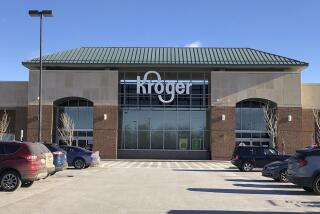Dual Brands: Doubling Up on Fast Food : Restaurants: Arby’s purchase of Long John Silver’s is the latest example. Some experts are wary of the concept.
- Share via
The pending merger of the Arby’s and Long John Silver’s restaurant chains is the most visible example yet of a trend in the industry: serving two brands of food under a single roof.
Triarc Cos., corporate parent of Arby’s, said Wednesday it has agreed to buy Long John Silver’s Restaurants Inc. for $525 million in cash, a deal that would create the nation’s sixth-largest fast-food chain, with $2.5 billion in annual revenue and 4,250 locations.
Rather than operate the chains independently, New York-based Triarc will convert at least 600 locations to serve both Arby’s roast beef sandwiches and Long John Silver’s seafood dishes. “It’s an absolute natural,” said Triarc spokesman Martin Shea.
Triarc isn’t the only restaurateur trying the dual-brand concept. Several other smaller chains, seeking some economy of scale to better compete against such international giants as McDonald’s and Taco Bell, are pairing their products.
Thus El Pollo Loco is testing sales of Foster’s Freeze desserts; Denny’s is dishing up Baskin-Robbins ice cream; hot dog king Wienerschnitzel recently added Winchell’s doughnuts to its menu, and, starting next month, some Carl’s Jr. hamburger outlets will also serve Green Burrito Mexican-style food.
Doubling up “gives us an opportunity to increase the number of locations as well as company revenue without the extreme expenditure of adding new facilities,” said Cliff Hiatt, president of Foster’s Old-Fashioned Freeze. Foster’s, based in Arroyo Grande, began testing soft ice cream stands during the summer inside a handful of El Pollo Loco restaurants.
Dual-brand proponents point to the popularity of shopping mall food courts as proof that consumers want a number of choices when they eat out.
For Triarc, combining Louisville, Ky.-based Long John Silver’s with Arby’s is not the first foray into dual brands. The company reports 50% sales increases resulting from earlier ventures--two Arby’s restaurants in Long Beach that also serve Green Burrito items, four Minneapolis restaurants that feature pasta from Sbarro’s, and an Arby’s-Long John Silver’s combination in Pittsburgh.
Some restaurant industry observers, however, question whether doubling up can give smaller chains an actual advantage in the fierce competition with the fast-food giants.
Ray Perry, chief operating officer of Irvine-based El Pollo Loco, said such combos are destined to fail unless customers see an obvious added attraction. Also, Perry cautioned, chains can tarnish hard-earned reputations if they link up with weak partners.
Other observers say that dual-brand restaurants may simply confuse the customer by offering too many choices. Nation’s Restaurant News, a trade magazine based in New York, pleaded in a recent editorial: “Can’t we pick somewhere to eat where we don’t have to choose yet again after we get there?”
But matches continue to be made, driven by the hope of boosting revenue at a relatively low cost.
Denny’s, for example, is betting that Baskin-Robbins shops, which will open inside its San Diego locations starting in November, will draw traffic in the afternoon and late at night, when the meal business slows. And Wienerschnitzel’s test-marketing of Winchell’s doughnuts is a bid to boost its breakfast business.
Perry of El Pollo Loco said that customers are, indeed, popping in for ice cream treats in the afternoon and late evening, which historically have been slow periods for the company’s restaurants.
In the end, cash register receipts will show how well burgers go with burritos and ice cream with chicken entrees.
For Carl’s Jr., the Green Burrito will be a serious test of whether Mexican-style menu items can help revive the burger chain’s dinner business, which historically has been slow. The marketing hook for the joint venture: “Two Great Tastes, One Great Place.”
But some industry executives remain cautious, wondering if maybe it isn’t too much of a good thing.
“Late one night we wondered, if two locations under one roof was supposed to be good, why not three or four?” said William R. Espinosa, vice president of strategic planning at Anaheim-based CKE Restaurants, parent company of Carl’s Jr. “Luckily,” he said, “we decided it was time to go home.”
More to Read
Inside the business of entertainment
The Wide Shot brings you news, analysis and insights on everything from streaming wars to production — and what it all means for the future.
You may occasionally receive promotional content from the Los Angeles Times.










